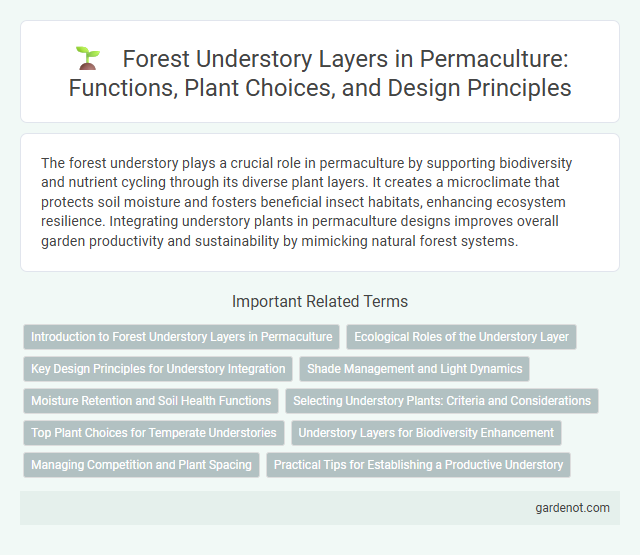The forest understory plays a crucial role in permaculture by supporting biodiversity and nutrient cycling through its diverse plant layers. It creates a microclimate that protects soil moisture and fosters beneficial insect habitats, enhancing ecosystem resilience. Integrating understory plants in permaculture designs improves overall garden productivity and sustainability by mimicking natural forest systems.
Introduction to Forest Understory Layers in Permaculture
Forest understory layers in permaculture consist of shade-tolerant shrubs, small trees, and herbaceous plants that thrive beneath the canopy, playing a crucial role in biodiversity and soil health. These layers act as natural mulch, reduce erosion, and enhance nutrient cycling, supporting the overall ecosystem's resilience. Integrating understory plants like nitrogen-fixing shrubs and medicinal herbs maximizes vertical space and creates sustainable, productive forest gardens.
Ecological Roles of the Understory Layer
The forest understory plays a crucial ecological role by providing habitat and food sources for diverse wildlife, including insects, birds, and small mammals. It enhances nutrient cycling and soil health through leaf litter decomposition and supports forest regeneration by nurturing seedlings and saplings under the canopy shade. This layer also contributes to microclimate regulation, maintaining humidity and temperature stability essential for ecosystem balance.
Key Design Principles for Understory Integration
Forest understory integration in permaculture emphasizes maximizing biodiversity by selecting shade-tolerant plants that improve soil fertility and prevent erosion. Designing multi-layered plant systems encourages nutrient cycling and habitat diversity, facilitating natural pest control and water retention. Proper spacing and species choice ensure efficient light capture and complement canopy trees, enhancing overall ecosystem resilience.
Shade Management and Light Dynamics
Forest understory plays a crucial role in permaculture by regulating shade management and optimizing light dynamics to support diverse plant growth. Effective shade management involves selecting shade-tolerant species and layering vegetation to maximize photosynthesis while protecting soil moisture. Understanding light dynamics ensures that understory plants receive adequate filtered sunlight, promoting biodiversity and enhancing ecosystem resilience.
Moisture Retention and Soil Health Functions
Forest understory plants play a crucial role in moisture retention by minimizing evapotranspiration and creating a microclimate that preserves soil hydration. Their dense root systems enhance soil structure, promote microbial activity, and increase organic matter decomposition, thereby improving soil fertility and health. This synergistic interaction supports nutrient cycling and stabilizes the ecosystem within permaculture design.
Selecting Understory Plants: Criteria and Considerations
Selecting understory plants in permaculture requires evaluating shade tolerance, root structure, and ecological function to ensure plant compatibility and ecosystem balance. Ideal candidates include nitrogen-fixing species, shade-loving herbs, and perennial ground covers that enhance soil fertility and support biodiversity. Consideration of water needs, growth rate, and pest resistance is crucial for sustainable understory integration and overall forest health.
Top Plant Choices for Temperate Understories
Shade-tolerant plants such as ferns, hostas, and wild ginger thrive in temperate forest understories, creating a rich, layered ecosystem beneath the canopy. These species improve soil health by enhancing organic matter and providing habitat for beneficial insects, supporting permaculture design principles. Selecting native plants like trilliums and Solomon's seal ensures resilience and ecological balance in temperate understory gardens.
Understory Layers for Biodiversity Enhancement
Forest understory layers, comprising shrubs, small trees, and herbaceous plants, play a crucial role in enhancing biodiversity within permaculture systems. These layers provide habitat and food sources for diverse wildlife, support nutrient cycling, and improve microclimates by regulating moisture and temperature. Incorporating a rich understory increases ecosystem resilience and fosters a self-sustaining environment essential for permaculture success.
Managing Competition and Plant Spacing
Effective management of forest understory in permaculture involves strategic plant spacing that reduces competition for sunlight, nutrients, and water among species. Optimizing plant distances encourages diverse growth, enhances soil health, and supports natural pest control by promoting beneficial habitat diversity. Careful selection of companion plants and monitoring resource allocation ensure sustainable understory development within forest systems.
Practical Tips for Establishing a Productive Understory
Selecting shade-tolerant plants such as ferns, herbs like mint and chamomile, and shade-loving vegetables like leafy greens supports a thriving forest understory. Mulching with organic materials conserves moisture, improves soil fertility, and suppresses weeds, enhancing plant growth and soil health. Integrating companion planting boosts biodiversity, pest control, and nutrient cycling, creating a resilient and productive understory ecosystem.
Forest understory Infographic

 gardenot.com
gardenot.com